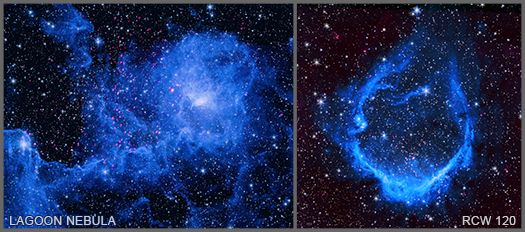Planetary formation theory has been undergoing a lot of changes recently, with an ever expanding litany of events that can potentially impact it. Everything from gravity to magnetic fields seems to impact this complex process. Now scientists want to add another confounding factor – massive solar flares thousands of times more powerful than the most powerful we have ever observed from the Sun.
That most powerful flare, known as the Carrington Event, was still strong enough to damage the Earth’s atmosphere, and likely would have done significant damage to the world’s electrical grid, if it hadn’t happened in 1859. But the kind of flares that Dr. Kostantin Getman of Penn State University and his colleagues found, while looking at young stars with the Chandra X-Ray Observatory, packed at least 100,000 times more energy than the Carrington Event.
The researchers found these powerful flares in 40 different star forming regions throughout the galaxy, observing a total of 24,000 stars. Amazingly, all 40 regions had these events happening in them. Incredibly powerful solar flares affect stars with different masses, and at different stages of evolution, such as when they are simply surrounded by dust or when they have planets formed already. One important detail is that all of the stars in the study average to be about 5 million years old – relatively young compared to our sun at 4.5 billion years. Another is the fact that the regular “super-flares” that had the power of 100,000 times a Carrington Event occurred multiple times per week on average in young stars, while more powerful megaflares, with at least 10 million times the energy of the Carrington Event, occurred around twice per year.
There were some similarities though. Dr. Getman and his colleagues modeled some 55 of the flares in detail to see how they compared to the more familiar, tame version from our own sun. They found loops of magnetic fields caused by the flares were anchored in the star itself, rather than connected between the star and its protoplanetary disk, similar to how coronal mass ejections work.
Credit – Chandra X-Ray Observatory YouTube Channel
Despite their similarities, that much activity that consistently is sure to have an impact on its surroundings. Many scientists had previously suggested that solar flare might help with the early stages of the planetary formation process – blowing away dust while causing rocks to meld together in pebbles, whose increased gravity then attracts other material. While this is still plausible, it is likely only one component of a much more complex story of planetary formation, which scientists are still learning more about.
Learn More:
Chandra – The Give and Take of Mega-Flares From Stars
The Astrophysical Journal – X-ray Super-Flares From Pre-Main Sequence Stars: Flare Energetics And Frequency
Chandra – Extra Photos
SciTech Daily – The Give and Take of Stellar Mega-Flares: By Studying Thousands of Young Stars, New Information Has Emerged
Space.com – Incredibly powerful megaflares from young stars are common, study shows
Lead Image:
Composite image of the Lagoon Nebula and RCW 120 from Chandra. These were two regions in the study that contained some of the flares detailed in the study.
Credit – X-ray – NASA / CXC / Penn State / K. Getman, et al; Infrared – NASA / JPL / Spitzer


The big question is how many million years before these flares stopped around the sun? The second one is How strong was the Earth’s magnetic field early in it’s history. There is increasing evidence that planetary atmospheres can survive close to actively flaring red dwarf stars with a strong enough magnetic fields. There is also reason to believe that tidally locked planets may have active volcanism indefinitely due to tidal stretching that regenerates lost atmospheric gasses. Such planets would be ideal candidates for life developing. Photosynthesis would be a problem due to the paucity of usable light, but there would be an almost infinite amount of time for adaptations to occur that would harness energy from what light a red dwarf does radiate.
Another possibility for life around red dwarf stars that a commenter of another artice mentioned and which fascinates me is the possibility of gas giants with moons orbiting such stars.
Gas giants like Jupiter that have large, strong magnetic fields could provide a protective enclave for its orbiting moons. I think the question then becomes what could the parameters be for HZ’s which could yield an exomoon with the right combination of radiation received and tidal stretching for volcanism to provide atmosphere and energy source for organisms…
It seems to me there could be a wide range of viable scenarios provided moons could reach a large enough size to hold onto enough atmosphere.. I guess the answer may come if we get better instruments that someday may be able to somehow observe/infer the existence of moons around exoplanets..
as a postscript,
diameter of Moon=3,472km and diameter of Titan=5,149.
Moon’s atmosphere = ~0km, Earth’s=300km and Titan’s atmosphere is 370km high.
distance Titan from Saturn= 1.2m km
distance Moon from Earth = 384k km
saturn is 95x the mass of earth which helps explain why Titan has atmosphere (tidal flexing of its core and a different composition) as opposed to earth’s moon
All this data is to illustrate the amazing diversity of environments the universe can build using dust and light! 🙂
http://www.sci-news.com/astronomy/massive-gas-giant-red-dwarf-gliese-3512b-07670.html